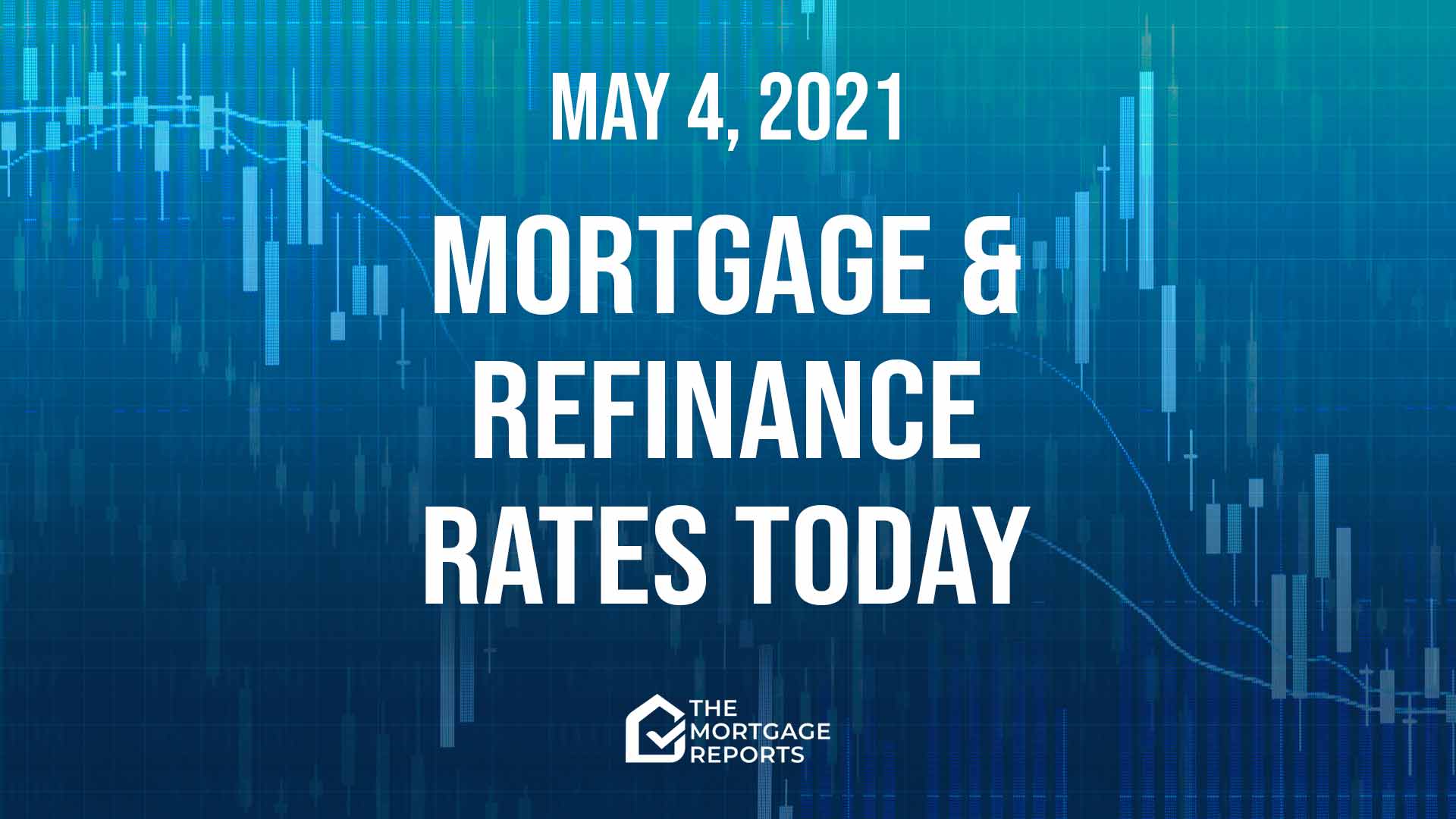
Today’s mortgage and refinance rates
Average mortgage rates edged lower again yesterday. That makes three consecutive business days of falls.
And we might be starting on the fourth. Because mortgage rates may fall yet again today.
Find and lock a low rate (May 4th, 2021)Current mortgage and refinance rates
| Program | Mortgage Rate | APR* | Change |
|---|---|---|---|
| Conventional 30 year fixed | |||
| Conventional 30 year fixed | 2.985% | 2.99% | Unchanged |
| Conventional 15 year fixed | |||
| Conventional 15 year fixed | 2.188% | 2.305% | Unchanged |
| Conventional 20 year fixed | |||
| Conventional 20 year fixed | 2.719% | 2.81% | -0.03% |
| Conventional 10 year fixed | |||
| Conventional 10 year fixed | 1.824% | 1.996% | -0.02% |
| 30 year fixed FHA | |||
| 30 year fixed FHA | 2.746% | 3.403% | Unchanged |
| 15 year fixed FHA | |||
| 15 year fixed FHA | 2.478% | 3.079% | +0.01% |
| 5 year ARM FHA | |||
| 5 year ARM FHA | 2.5% | 3.194% | Unchanged |
| 30 year fixed VA | |||
| 30 year fixed VA | 2.351% | 2.523% | -0.02% |
| 15 year fixed VA | |||
| 15 year fixed VA | 2.25% | 2.571% | Unchanged |
| 5 year ARM VA | |||
| 5 year ARM VA | 2.5% | 2.372% | Unchanged |
| Rates are provided by our partner network, and may not reflect the market. Your rate might be different. Click here for a personalized rate quote. See our rate assumptions here. | |||
COVID-19 mortgage updates: Mortgage lenders are changing rates and rules due to COVID-19. To see the latest on how coronavirus could impact your home loan, click here.
Should you lock a mortgage rate today?
There’s no denying that April was a good month for mortgage rates. And the first two business days of May have been helpful, too. But the falls have been slowing since April 15.
And that means the benefits of floating have been reducing while the risks of doing so remain heightened. Still, you might choose to continue to float until these rates begin to rise appreciably.
So my personal rate lock recommendations remain:
- LOCK if closing in 7 days
- LOCK if closing in 15 days
- LOCK if closing in 30 days
- LOCK if closing in 45 days
- LOCK if closing in 60 days
But I don’t claim perfect foresight. And your personal analysis could turn out to be as good as mine — or better. So you might choose to be guided by your instincts and your personal tolerance for risk.
Market data affecting today’s mortgage rates
Here’s a snapshot of the state of play this morning at about 9:50 a.m. (ET). The data, compared with roughly the same time yesterday, were:
- The yield on 10-year Treasurys fell to 1.57% from 1.62% (Good for mortgage rates.) More than any other market, mortgage rates normally tend to follow these particular Treasury bond yields, though less so recently
- Major stock indexes were lower on opening. (Good for mortgage rates.) When investors are buying shares they’re often selling bonds, which pushes prices of those down and increases yields and mortgage rates. The opposite happens when indexes are lower
- Oil prices rose to $65.32 from $64.14 a barrel. (Bad for mortgage rates*.) Energy prices play a large role in creating inflation and also point to future economic activity.
- Gold prices inched up to $1,792 from $1,788 an ounce. (Neutral for mortgage rates*.) In general, it’s better for rates when gold rises, and worse when gold falls. Gold tends to rise when investors worry about the economy. And worried investors tend to push rates lower
- CNN Business Fear & Greed index — Fell to 51 from 56 out of 100. (Good for mortgage rates.) “Greedy” investors push bond prices down (and interest rates up) as they leave the bond market and move into stocks, while “fearful” investors do the opposite. So lower readings are better than higher ones
Caveats about markets and rates
Before the pandemic and the Federal Reserve’s interventions in the mortgage market, you could look at the above figures and make a pretty good guess about what would happen to mortgage rates that day. But that’s no longer the case. We still make daily calls. And are usually right. But our record for accuracy won’t achieve its former high levels until things settle down.
So use markets only as a rough guide. Because they have to be exceptionally strong or weak to rely on them. But, with that caveat, so far mortgage rates today look likely to fall. Just be aware that intraday swings (when rates change direction during the day) are a common feature right now.
Find and lock a low rate (May 4th, 2021)
Important notes on today’s mortgage rates
Here are some things you need to know:
- Typically, mortgage rates go up when the economy’s doing well and down when it’s in trouble. But there are exceptions. Read ‘How mortgage rates are determined and why you should care
- Only “top-tier” borrowers (with stellar credit scores, big down payments and very healthy finances) get the ultralow mortgage rates you’ll see advertised
- Lenders vary. Yours may or may not follow the crowd when it comes to daily rate movements — though they all usually follow the wider trend over time
- When daily rate changes are small, some lenders will adjust closing costs and leave their rate cards the same
- Refinance rates are typically close to those for purchases. But some types of refinances are higher following a regulatory change
So there’s a lot going on here. And nobody can claim to know with certainty what’s going to happen to mortgage rates in coming hours, days, weeks, or months.
Are mortgage and refinance rates rising or falling?
Today and soon
The economic news we’ve all been seeing recently has been so exceptionally good that it’s hard to see anything coming between us and the much-anticipated boom that’s due later this year.
Just yesterday, The New York Times reported:
New York and its neighbors New Jersey and Connecticut announced on Monday that they were lifting almost all their pandemic restrictions, paving the way for a return to fuller offices and restaurants, a more vibrant nightlife and a richer array of cultural and religious gatherings for the first time in a year.
— NYT, New York Region to Accelerate Reopening, Raising Hopes and Anxiety, April 3, 2021
Yet still, bond investors seem hesitant to react as they normally would. Bond yields should be rising — and with them mortgage rates. But they’re not.
Fears
How come? Well, investors are rightly concerned by four COVID-19-related fears:
- The impact of the pandemic on some key trading partners, most notably India
- The possibility of new variants of the COVID-19 virus that could be resistant to vaccines
- A possibility of the US never achieving herd immunity owing to vaccine hesitancy
- Supply-chain bottlenecks that could see supply failing to keep up with demand when the economy gets back to normal — or a new normal
There was evidence of the last of those in an economic report published yesterday. The Institute for Supply Management’s (ISM) manufacturing index was still very positive. But it showed a slowing in the rate of recovery
Chair of the ISM manufacturing business survey committee Timothy Fiore noted that purchasing managers were reporting: “that their companies and suppliers continue to struggle to meet increasing rates of demand due to coronavirus impacts limiting availability of parts and material.”
So bond investors aren’t being wholly irrational in shrugging off the good economic news. But you have to wonder for how long they can continue to do so when their fears may turn out to be either short-lived or groundless.
For more background, check out our latest weekend edition of this report.
Recently
Over much of 2020, the overall trend for mortgage rates was clearly downward. And a new, weekly all-time low was set on 16 occasions last year, according to Freddie Mac.
The most recent weekly record low occurred on Jan. 7, when it stood at 2.65% for 30-year fixed-rate mortgages. But then the trend reversed and rates rose.
However, those rises were mostly replaced by falls in April, though those have moderated since the middle of the month. Indeed, Freddie’s Apr. 29 report puts that weekly average at 2.98% (with 0.7 fees and points), up from the previous week’s 2.97%.
Expert mortgage rate forecasts
Looking further ahead, Fannie Mae, Freddie Mac and the Mortgage Bankers Association (MBA) each has a team of economists dedicated to monitoring and forecasting what will happen to the economy, the housing sector and mortgage rates.
And here are their current rates forecasts for the remaining quarters of 2021 (Q2/21, Q3/21, Q4/21) and the first quarter of 2022 (Q1/22).
The numbers in the table below are for 30-year, fixed-rate mortgages. Freddie’s were updated on April 14, Fannie’s on April 12 and the MBA’s on April 22.
| Forecaster | Q2/21 | Q3/21 | Q4/21 | Q1/22 |
| Fannie Mae | 3.2% | 3.3% | 3.4% | 3.5% |
| Freddie Mac | 3.2% | 3.3% | 3.4% | 3.5% |
| MBA | 3.4% | 3.6% | 3.7% | 3.9% |
However, given so many unknowables, the current crop of forecasts might be even more speculative than usual.
Find your lowest rate today
Some lenders have been spooked by the pandemic. And they’re restricting their offerings to just the most vanilla-flavored mortgages and refinances.
But others remain brave. And you can still probably find the cash-out refinance, investment mortgage or jumbo loan you want. You just have to shop around more widely.
But, of course, you should be comparison shopping widely, no matter what sort of mortgage you want. As federal regulator the Consumer Financial Protection Bureau says:
Verify your new rate (May 4th, 2021)Shopping around for your mortgage has the potential to lead to real savings. It may not sound like much, but saving even a quarter of a point in interest on your mortgage saves you thousands of dollars over the life of your loan.



